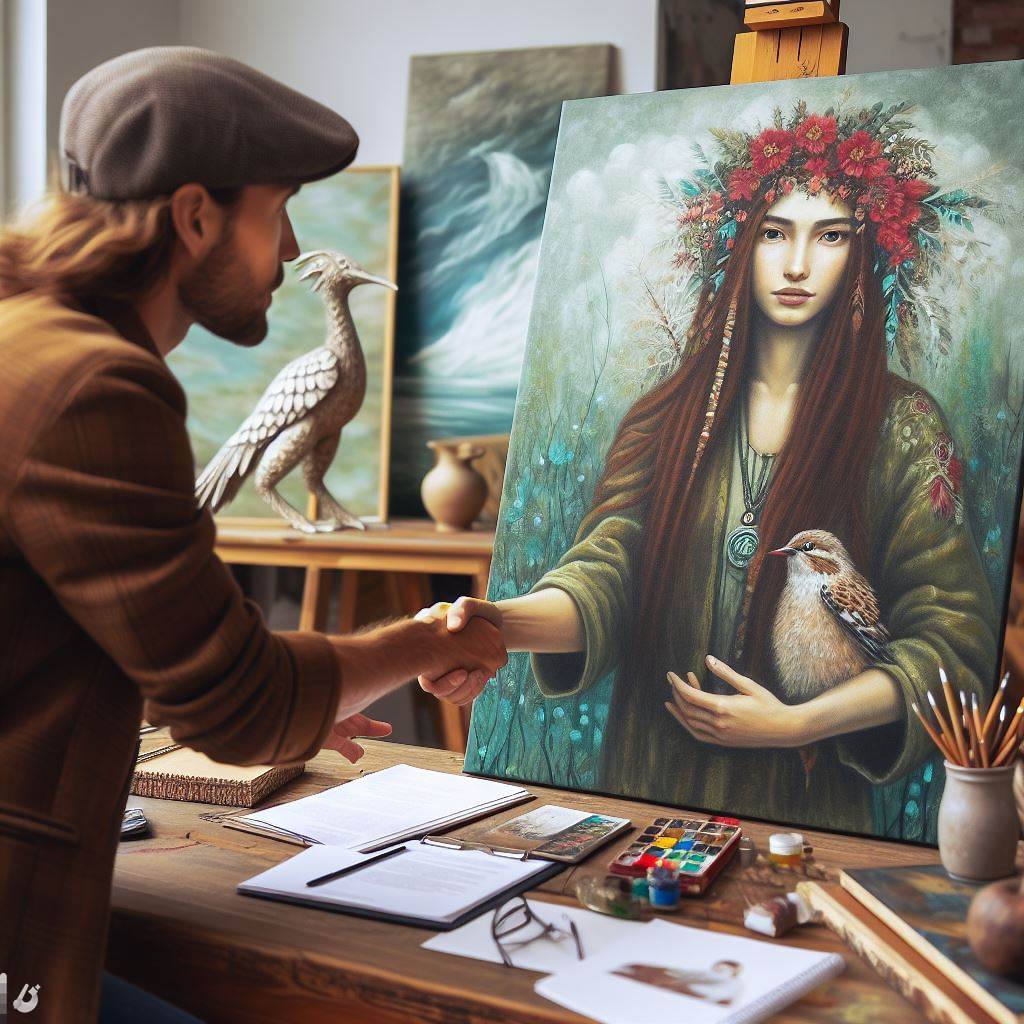Introduction
The Canadian art market is a thriving industry that artists and enthusiasts should understand.
Knowing the market is crucial for success in the industry.
This blog post aims to provide useful tips and tricks for navigating the Canadian art market.
Market Overview
Size and scope of the Canadian art market
- Statistics reveal the immense value of the Canadian art market, making it a significant player.
- The market’s presence is concentrated in major cities and regions across the country.
The role of galleries, auction houses, and art fairs
- Galleries, auction houses, and art fairs are key players shaping the Canadian art market.
- Understanding how these platforms operate is crucial as they hold great significance in the market.
- Engaging with galleries provides artists and collectors with a platform for showcasing and purchasing art.
- Auction houses play a vital role in facilitating sales through auctions, attracting both local and international buyers.
- Art fairs gather a diverse range of artists, galleries, and collectors in one space, fostering new connections and opportunities.
- Pros of engaging with galleries include personalized representation, curated exhibitions, and potential long-term artist-gallery relationships.
- Cons of galleries include high commission fees, limited gallery space, and the need for established reputations to gain representation.
- Auction houses offer wider exposure, reputation validation, and direct sales to interested buyers.
- However, cons of auctions involve commission fees, competitive bidding, and the pressure for artworks to meet reserve prices.
- Art fairs provide a platform for direct interaction with collectors, exposure to new markets, and potential sales.
- On the downside, the costs of participating in art fairs can be high, and success relies on standing out among numerous exhibitors.
Read: Breaking In: How to Start Your Art Career in Canada
Building Your Network
Importance of networking in the art market
Building a strong network is crucial in the art market, as it helps artists gain exposure, opportunities, and support.
Networking enables artists to connect with other professionals who can offer mentorship, collaborations, and valuable advice.
By developing a network, artists can expand their reach and get their artwork in front of potential buyers and collectors.
Joining local artist communities and organizations
Joining local artist communities and organizations provides artists with a platform to meet like-minded individuals.
These communities often organize events, workshops, and exhibitions, allowing artists to showcase their work and make connections.
Being part of these communities can also lead to collaborations and opportunities for joint projects and exhibitions.
Attending art events, exhibitions, and openings
Attending art events, exhibitions, and openings is a great way for artists to network and engage with the art community.
Artists can meet curators, gallery owners, and collectors during such events, which can open doors to potential opportunities.
It is essential to come prepared with business cards and a portfolio to make a lasting impression on potential contacts.
Utilizing social media platforms to connect with artists, galleries, and collectors
Social media platforms like Instagram, Facebook, and LinkedIn are powerful tools for networking in the art market.
Artists can promote their artwork, engage with followers, and connect with other artists, galleries, and collectors.
Utilizing hashtags specific to the art community can increase visibility and attract potential collaborators and buyers.
Benefits of collaborating with other artists or participating in group shows
Collaborating with other artists or participating in group shows allows artists to explore new ideas and techniques.
Working with other artists can foster creativity, provide feedback, and help artists grow both personally and professionally.
Participating in group shows exposes artists to new audiences and collectors, increasing their chance of sales and recognition.
Collaborations and group shows also provide opportunities for shared resources, costs, and marketing efforts.
In short, building a strong network is crucial for artists navigating the Canadian art market.
By joining local artist communities, attending art events, and utilizing social media platforms, artists can connect with others.
Collaborating with fellow artists and participating in group shows also offers numerous benefits in terms of personal and professional growth.
Networking is an ongoing process that requires active participation and a willingness to engage with the art community.
Artists who establish strong networks increase their chances of success, recognition, and thriving in the competitive art market.
Unlock Your Career Potential
Visualize a clear path to success with our tailored Career Consulting service. Personalized insights in just 1-3 days.
Get StartedRead: The Future of Writing Careers in Canada
Understanding Pricing and Valuation
Factors that influence the value of art:
- Significance of the artist’s reputation: The reputation of the artist plays a crucial role in determining the value of their artwork. Artists with established careers and a strong reputation often command higher prices.
- Quality and uniqueness of the artwork: The quality and uniqueness of the artwork directly impact its value. Artworks that demonstrate exceptional craftsmanship, innovation, and creativity tend to have higher valuations.
- Demand and trends in the market: The demand for specific artists or styles can greatly affect the value of art. Market trends, popular themes, and collector preferences all contribute to the fluctuation in prices.
Researching and comparing prices
- Online resources and databases: Utilizing online resources and databases can provide valuable insights into the pricing of artworks. Websites such as ArtPrice, Artnet, and Artsy offer comprehensive databases and market reports that allow artists to track sales and compare prices.
- Consulting experts or appraisers: Seeking advice from experts or professional appraisers can provide an in-depth understanding of the market and help artists determine appropriate pricing. These professionals have extensive knowledge and experience in valuing art.
Determining fair pricing for your own art
- Evaluate the quality and uniqueness: Assess the quality of your artwork objectively and consider its uniqueness compared to similar pieces in the market. This will help you determine a fair starting price.
- Research recent sales: Research recent sales of similar artworks by artists of comparable reputation to gauge current market values. This will give you a benchmark for pricing your own art.
- Consider your target audience: Understand your target audience and their buying power. Adjust your pricing accordingly, keeping in mind what collectors in your niche are willing to pay.
- Include hidden costs: Consider expenses such as materials, framing, shipping, and gallery commissions when determining the pricing of your art. Factoring in these costs ensures that you don’t undercut yourself.
- Be open to negotiation: In the art market, negotiation is common. Consider setting a slightly higher initial price to allow room for negotiation without compromising the perceived value of your work.
- Experiment with pricing: As you navigate the art market, be open to experimenting with different price points. Adjust your prices based on feedback, sales, and emerging trends to find the sweet spot that maximizes your income.
Understanding the factors that influence the value of art, researching and comparing prices, and determining fair pricing are essential aspects of navigating the Canadian art market.
By incorporating these tips and tricks, artists can make informed decisions about pricing their artwork and positioning themselves for success in the competitive market.
Remember, finding the right balance between value and profitability is key to thriving in the Canadian art scene.
Read: Cultural Diversity in Canadian Acting Scene

Exhibiting and Selling Your Art
Choosing the right gallery or exhibition space
- Research various galleries to understand their preferences and what kind of art they exhibit.
- Submit portfolios and proposals to galleries that align with your artistic style and vision.
Preparing for art fairs and exhibitions
- Learn about the selection process for art fairs and exhibitions to increase your chances of being accepted.
- Create an effective presentation of your artwork and an artist statement that properly communicates your vision.
Selling strategies, such as pricing, negotiation, and commission considerations
- Set prices for artwork considering size, medium, and your experience. Be confident in your value and negotiate when needed.
- Research galleries, attend art openings, and talk to artists to find the right exhibition space for your style.
- Customize portfolio submissions to galleries, highlighting relevant work and including a professional artist statement.
- Explore art fairs and exhibitions, understanding selection processes and presenting your work effectively.
- Prepare cohesive displays with attention to layout, lighting, and supporting materials for art fairs and exhibitions.
- Determine fair prices based on size, medium, complexity, and market research. Be open to negotiation while valuing your work.
- Understand gallery commission structures (typically 30-50%) and factor them into your pricing strategy.
- Consider collaboration with agents or consultants, ensuring fees align with industry standards.
- Exhibit confidence in the value of your art during negotiations for successful sales.
- Adopt thoughtful and strategic planning to position yourself for success in the Canadian art market.
Read: Building Your Brand as a Writer in Canada
Building an Online Presence
Importance of a professional and engaging website
- A professional and engaging website is crucial for artists to showcase their work and attract potential buyers.
- A well-designed website can leave a lasting impression on visitors and make them inclined to explore further.
- It provides a centralized platform for artists to display their portfolio, biography, and contact information.
- A website can establish credibility and professionalism, making it easier for potential buyers to trust the artist.
- It allows artists to have complete control over their online presence, branding, and how their work is presented.
B. Utilizing social media platforms for promotion and networking
- Social media platforms like Instagram, Facebook, and Twitter are powerful tools for artists to promote their work.
- Creating a dedicated artist profile helps to build a following and reach a wider audience.
- It allows artists to engage with fans, collectors, and other artists, fostering networking opportunities.
- Artists can share behind-the-scenes glimpses, upcoming exhibitions, and interact with their audience in real-time.
- Social media also provides an avenue for collaborations, partnerships, and exposure to potential buyers.
Showcasing your art online and leveraging online galleries
- Online galleries provide artists with a global platform to showcase their artwork to a diverse audience.
- Artists can submit their work to online galleries and gain exposure to art enthusiasts, collectors, and galleries.
- Online galleries often have specialized categories, making it easier for collectors to discover specific types of art.
- It provides artists with the opportunity to sell their work and establish new connections in the art world.
- Showcasing art online allows artists to present a curated collection and capture the attention of potential buyers.
Online sales platforms and e-commerce options for artists
- Online sales platforms like Etsy, Shopify, and Saatchi Art offer artists a convenient way to sell their artwork.
- These platforms provide e-commerce tools and secure payment options, ensuring a seamless buying experience.
- Artists can reach a global customer base, eliminating geographical barriers to selling their art.
- Online sales platforms often have built-in marketing and promotional features to help artists increase visibility.
- Artists can leverage these platforms to sell prints, originals, and other art-related merchandise directly to buyers.
In fact, building an online presence is essential for artists in today’s digital age.
A professional website, active presence on social media, leveraging online galleries, and utilizing online sales platforms provide artists with opportunities to showcase their work, connect with a wider audience, and sell their art to buyers from all over the world.
It is crucial for artists to embrace technology and actively engage in the online art market to thrive in the competitive industry.
Researching and Evaluating Opportunities
Keeping up with art market news and trends
- Subscribe to art magazines and newsletters for the latest updates on the Canadian art market.
- Follow reputable art blogs and websites that provide insights into market trends and emerging artists.
- Attend art fairs, exhibitions, and gallery openings to network and stay informed about current market developments.
Researching grant opportunities and funding programs
- Explore government websites, such as the Canada Council for the Arts, to find grants and funding options for artists.
- Join online forums and communities where artists share information about available grants and funding sources.
- Reach out to local art organizations and associations for advice on grants and funding programs specific to your region.
Recognizing fraudulent or untrustworthy venues or individuals
- Do thorough research on galleries, art agents, or exhibition spaces before entering into any agreements or partnerships.
- Check for online reviews or testimonials from other artists who have collaborated with the venue or individual.
- Beware of red flags such as upfront fees, unrealistic promises, or lack of transparency regarding sales and commissions.
Seeking professional advice for legal and financial aspects
- Hire an art attorney or seek legal advice to ensure your contracts, agreements, and copyright issues are properly handled.
- Consult with a financial advisor who specializes in the art market to manage taxes, investments, and financial planning.
- Join professional artist associations or organizations that offer resources and guidance on legal and financial matters.
By actively researching and evaluating opportunities, artists can navigate the Canadian art market more effectively.
Keeping up with the latest news and trends allows artists to be aware of market shifts and make informed decisions.
Researching grant opportunities and funding programs helps artists secure financial support for their projects.
Recognizing fraudulent or untrustworthy venues or individuals protects artists from scams and potential harm.
Finally, seeking professional advice ensures that legal and financial aspects of an artist’s career are handled properly.
With these tips and tricks, artists can navigate the Canadian art market with confidence and success.
Learn More: The Canadian Artist’s Guide to Gallery Representation
Gain More Insights: Digital Age Journalism in Canada Today
Conclusion
Recap of the main points covered in the blog post
Throughout this blog post, we have explored the Canadian art market and provided various tips and tricks for navigating it successfully.
We discussed the importance of understanding the market’s dynamics, conducting thorough research, and building strong relationships with galleries and collectors.
Encouragement for artists and art enthusiasts to explore the Canadian art market
We encourage both artists and art enthusiasts to delve into the Canadian art market.
It presents a wealth of opportunities for artists to showcase their talent and for art enthusiasts to discover unique and captivating artworks from emerging and established artists.
Emphasizing the continuous learning process in navigating the market
Lastly, we want to emphasize that navigating the Canadian art market is a continuous learning process.
The market is constantly evolving, and artists and art enthusiasts must stay curious, open-minded, and adaptive.
By staying informed about industry trends and actively seeking new knowledge, individuals can stay ahead in this competitive market.
In closing, the Canadian art market offers immense potential for artists and art enthusiasts.
By following the tips and tricks shared in this blog post and embracing a lifelong learning mindset, individuals can successfully navigate this dynamic market and thrive in their artistic pursuits or appreciation of art.




